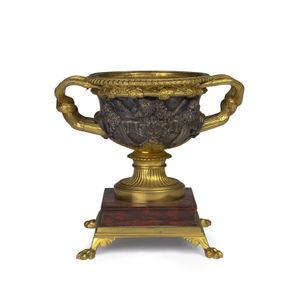Classical Style Bronze Outdoor Fountain with Acanthus Leaf Standard
A monumental patinated bronze outdoor fountain in the classical style, with a shallow circular bowl moulded to the underside with a leaf tip border, above an acanthus leaf cast standard and an octagonal base cast with lion mask heads, (bend to one section of the base near pump access area, no access hatch, no pump), approximately 185 cm diameter x 230 cm high
You must be a subscriber, and be logged in to view price and dealer details.
Subscribe Now to view actual auction price for this item
When you subscribe, you have the option of setting the currency in which to display prices to $Au, $US, $NZ or Stg.
This item has been sold, and the description, image and price are for reference purposes only.
- Acanthus - A stylized leaf motif, one of the primary decorative elements of classical Greek and Roman architecture, derived from the genus of flowering plants in the family Acanthaceae, native to tropical and subtropical regions of the Mediterranean area. It is a common element in classical Greek and Roman design, and is often seen in Corinthian and Composite order columns and used as a decorative element in English, European and Australian furniture, particularly on the curve of a leg, and as decoration for a corbel.
- Lion Mask - The lion mask has been used for centuries in various forms of art and design, including furniture, silver, and ceramics, and is usually y depicted as a stylized representation of the face of a lion, often with an open mouth and protruding tongue. and is often used as a handle, knob, or other decorative element.
In furniture design, lion masks were popular in the neoclassical and Empire styles of the late 18th and early 19th centuries. They were often used as decorative elements on the legs or arms of chairs, as well as on cabinet and drawer pulls. It was also used as a handle, knob, or other decorative element.
In silverware design, lion masks were often applied to tea and coffee pots, as well as on candlesticks, snuff boxes, and other small silver items. The lion mask was often used in combination with other neoclassical motifs, such as laurel wreaths or acanthus leaves, to create a sense of grandeur and classical elegance.
In ceramics, lion masks were often depicted in relief, and were sometimes used in combination with other decorative elements, such as garlands or swags. - Bronze - An alloy of copper and tin, traditionally in the proportions of about 9 parts of copper to 1 part of tin.
The discovery of bronze in Western Asia in the 4th century enabled people to create metal objects which were superior to those previoulsy possible because of its strength and hardness, and it has been used throughout the world for weapons, coins, tools, statuary and other decorative items.
It is very fluid in a molten state, and its hardness, strength when set, and non-corrosive properties makes it most suitable for casting sculpture.
This item has been included into following indexes:
Visually similar items

A large terracotta classical urn on pedestal, French 19th century, 156 cm high
Sold by
in
for
You can display prices in $Au, $US, $NZ or Stg.

Dresden figural pedestal centrepiece with a reticulated bowl & three applied female musician figures. Height 59 cm
Sold by
in
for
You can display prices in $Au, $US, $NZ or Stg.

Late 19th century electric table lamp Sevres style porcelain body and gilt metal mounts
Sold by
in
for
You can display prices in $Au, $US, $NZ or Stg.

An ormolu and bronze urn mounted on a rouge marble base, elaborately decorated with classical images, 20 cm high
Sold by
in
for
You can display prices in $Au, $US, $NZ or Stg.
